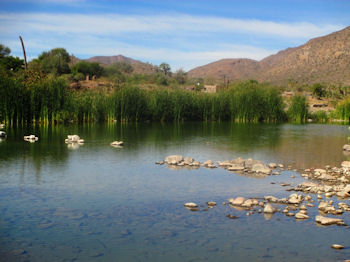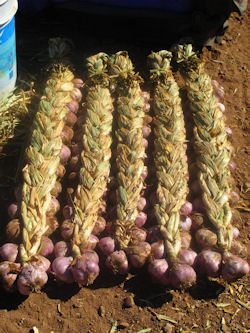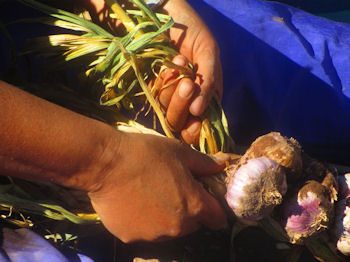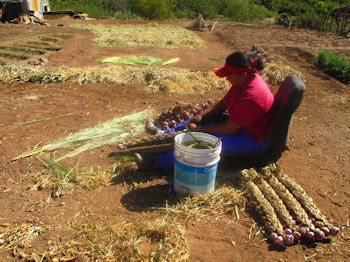 |  |
By Martina

There is always a bit of excited anticipation when I take a side road into a Baja place that I have never been before. South of Santa Rosalia, BCS and east into the mountains is a small pueblo called San José de Magdalena. There is something organic about driving into the heart of the mountains far from what is thought of as a tourist destination. When a story calls, I'll follow with little hesitation, really not knowing how it will turn out. Kind of like jumping off a cliff, but a lot safer most of the time. I was in search of the garlic growers of Baja California and the history of Magdalena.
It was a lovely clear morning for the drive in the mountains. The eight miles in was easy with a newly paved road almost all the way. Mexico has taken on the job of opening up some of these heretofore isolated communities, a real gift from the Mexican government. Recorded in these mountains is an ancient drama of its volcanic violence. The hills appear tormented into shape with valleys gouged out by flood waters. The grades are steep, but the road is a joy to drive. Up over one ridge and dropping down the other side, quite suddenly there is a lush green field in the midst of the Cardón cactus, scrub and palm trees.
Further on there are a few homes and the peoples' cemetery. The mausoleums looking like tiny houses in different colors, a quiet village created for the ancestors. The pavement ended just short of Magdalena. I followed a white rocky one lane road that curled around a pond thick with California Bulrush growing at its edges. The damp mossy fragrance floated through the warm dry air. A throaty bull frog made its presence known and mud hens glided across the glassy surface. A bubbling stream seeped from the pond and continued on down into the valley. This area sustained life for thousands of years because there was water.

The first people to enjoy Baja's natural beauty were the Cochimi and Guaycura Indians. Written history came later, so there is little record of their lives that remain. Yet they were a living force before they were "discovered." They were hunter-gatherers and moved with the seasons, but built small villages and maintained a life for 7,000 years or more. Visita de San José de Magdalena was founded in 1774 by the Dominican missionaries to minister to the Cochimí Indians. It was an outlying area of the Misión Santa Rosalía de Mulegé. This visita, or subordinate mission station, was closed in 1828. Ruined walls of adobe brick can still be seen combined with other more modern building materials in haphazard construction of metal and earthen bricks. Written history shows that the indigenous of the Baja did not survive being discovered. But their ancestors live on in the faces and behind the eyes of many people living here today.
I had thought that I would find expansive fields as this area is known for its garlic production. But this was not a huge California agricultural center as I imagined that I'd find. Undaunted, I pulled into the humble community with its gray block church and a school alive with children who waved as I passed. There were mounds of garlic garlands on front porches of some of the homes, but there were no people about. I parked my car, grabbed my camera and started to walk, not actually knowing where I was going, just following a dirt road in search of the story and there she was. A woman in red sat on the ground weaving the garlic bulbs into long strands. Her hands rough from the harsh work. I asked permission to step into the garden area and when she looked up, I paused as I saw her lovely face and shy smile. Her name was Lupita.
She shared the process of how the garlands came into being. First, the "seed" is actually one of the sections of the garlic bulb which is planted in September. Through the temperate and rainy months, the one clove has become a full garlic bulb again. Such magic. By February and into March it is time for the harvest. The men use special tools to dig the garlic bulbs, leaving the long grass-like leaves to dry. But they cannot be allowed to completely dry as they would be too brittle to weave. They are covered, sprinkled with water to maintained pliability. The California Bulrush is collected to use as the cord for binding. Lupita's hands moved confidently as she selected each bulb, tied it off with the bulrush and laid them in neat rows. It took her 15 minutes to complete one strand. She would work like this all day long for the entire harvesting. Her work ends up in grocery stores and tourist gift shops. Following a story into the unknown is always a surprise, something is added to what I think it is going to be. In this case the story was about Lupita. A humble woman working in the old ways. We may never know her people, yet it is so important that they continue to thrive in these hidden places of the Baja. In some mysterious way, their existence completes us.
Directions From Santa Rosalia south: 16 miles near kilometer watch for a paved road to the right at 169 and about 20 minutes. There is no sign on the main road. 17 miles round trip, no services.


Martina's email: mteomaya(at)gmail.com